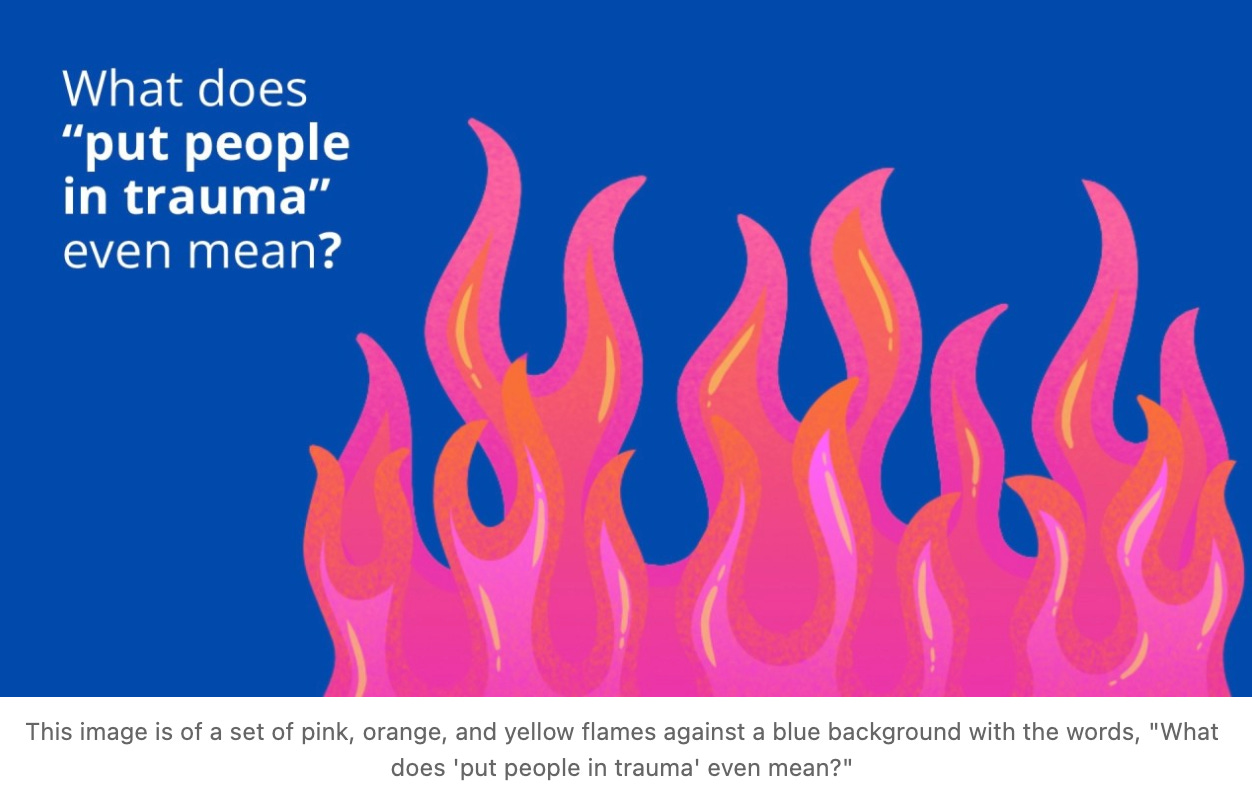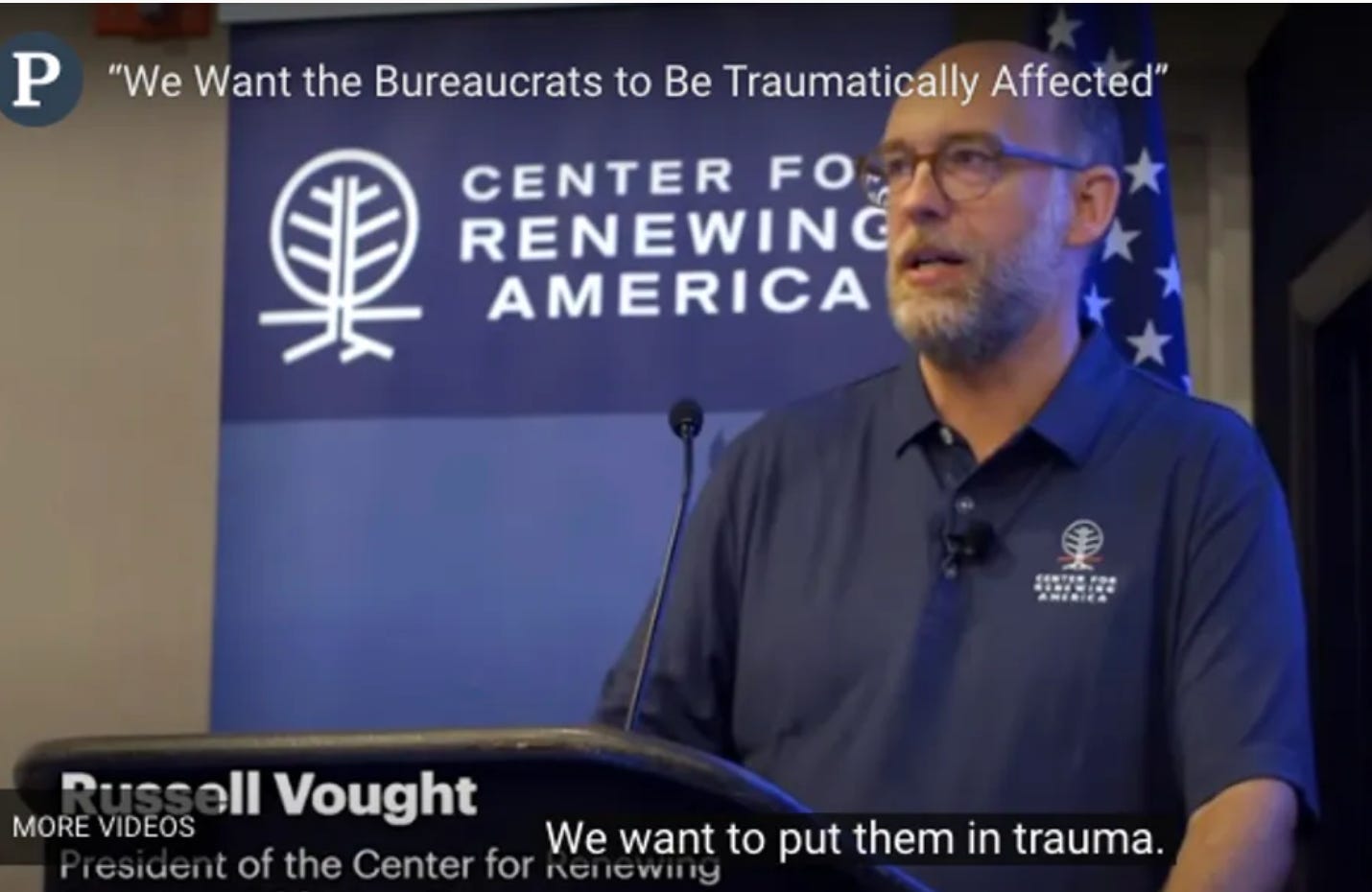From Don: We are witnessing an incredible and thoughtless degradation of state capacity right now. That is bad for us all as citizens who depend upon government services. But we can’t forget the human toll being imposed on public employees. Trump officials have repeatedly denigrated those that work from them, even promising to put them “in trauma.” This piece explores what that really means.
The public sector has typically been able to hire talented employees not because they pay better, but because of the sense of mission that comes with public work, as well as a promise of relatively stable employment. Both of those are being torn away right now, in ways that I think will have long-term consequences for all of us.
I am a current federal employee with the United States Digital Corps. I was required to be interviewed by a member of the DOGE team and am also on the termination list of employees due to probationary status. I wrote this in my personal capacity, but the perspectives I share are deeply connected to my professional responsibility to advance ethical, trauma-informed practices in public sector innovation.
TL;DR: The forced mass terminations and agency restructuring under the Trump administration have activated psychological and emotional distress among federal workers. Employees report hypervigilance, institutional betrayal, physiological symptoms of stress, loss of identity, grief, and collective trauma.
The administration's rhetoric explicitly frames these actions as an intentional effort to induce trauma, as evidenced by Russell Vought’s statement:
We want the bureaucrats to be traumatically affected. When they wake up in the morning, we want them to not want to go to work because they are increasingly viewed as the villains.
The following analysis applies trauma frameworks to understand the impact of these upheavals.
Traumatic Responses Among Federal Workers: An Analysis of "Inside the Trump Purge"
I have been writing about what it means to "put people in trauma." This podcast episode of The Daily, "Inside the Trump Purge: Federal Workers Tell Their Stories" (YouTube, Apple podcasts) provides a clear and striking account of the psychological, emotional, and physiological toll inflicted on government employees affected by mass terminations and agency restructuring.
I'm sharing here my categorization and analysis of the traumatic responses I observed in listening to these workers' testimonies. I have used my knowledge, education, and experience of trauma and traumatic studies as the framework for this analysis.
Hypervigilance, paranoia, and fear of retaliation
Institutional betrayal and a loss of trust
Physiological and psychological distress
A profound sense of grief, helplessness, and mourning
Collective trauma and anticipatory anxiety
A traumatic experience occurs when something happens too often, too fast, and/or for too long. By all accounts, many federal employees are experiencing a deeply traumatic experience. These workers will likely carry lasting emotional and professional scars from this experience, particularly as they attempt to navigate new employment, financial insecurity, and a fractured trust in government institutions.
What follows here is a more detailed breakdown of what I heard in the words, voices, and tones of the many federal employees who were featured.
1. Hypervigilance and Paranoia
Many employees described a heightened state of alertness, fearing retaliation and job loss. People became fearful that they or their colleagues could be reported, reinforcing a state of psychological distress akin to McCarthyism.
"That afternoon, in fact, several colleagues that had been working on DEI initiatives were fired, sent home. One of them I had only been talking to about two hours before he was sent home. That was very chilling. A sense of paranoia arose."
"We started getting emails. First there was the one asking us to report any employees who were disguising the fact that they’re doing DEI work."
"A sense of paranoia arose."
Trauma Connection: Hypervigilance is a common and typical response to prolonged stress or systemic oppression, often seen in survivors of institutional betrayal.
2. Institutional Betrayal and Betrayal Trauma
Employees experienced profound disillusionment with the government agencies they had dedicated their careers to.
"We were told to take our pronouns down."
"Things like gender-based violence or women’s empowerment, even Happy Lunar New Year. It was like, oh, gosh, should we not even be saying that?"
"I keep thinking — and I’ll try and say this without crying. A couple years ago, I was working for the federal government about 15 hours a day... I believed in the work. And so I can’t describe how hurtful it is to receive an email saying that you should go from a less productive public space to go to a more productive private space."
Trauma Connection: Many workers felt betrayed by the institutions they had dedicated their careers to. This aligns with institutional betrayal trauma: the emotional fallout when a trusted institution violates one’s sense of safety and fairness. Betrayal trauma occurs when an institution or authority figure that one trusts becomes the source of harm, leading to deep emotional distress and a loss of faith in the system.
3. Fight, Flight, Freeze, or Fawn Responses
Responses varied across different employees:
"If anything, it’s cemented my sense of resolve to stay in the job that I loved, that provides for my family, that improves my community." (Fight)
"I was at an off-site meeting about a new project that we had starting up... At 2 o’clock, Marco Rubio had sent out the stop-work order. My colleague said, I’m really sorry, but we have to end this meeting immediately." (Freeze)
"A group of us that were all in the same team that live in the DC area decided we would all turn in our laptops and badges at the same time so that we could see each other." (Fawn - finding collective support)
Trauma Connection: The "Four F" trauma response model (Fight, Flight, Freeze, Fawn) explains how individuals instinctively react to perceived threats. The sudden and unpredictable nature of the terminations activated various survival mechanisms.
4. Physiological and Emotional Distress
Federal employees discussed symptoms of anxiety, panic, and physiological stress responses, including tight chest, disrupted sleep, loss of appetite, and hypervigilance. These are signs of acute stress reactions, and if prolonged, could develop into post-traumatic stress symptoms.
"The stress is starting to build. Like, job’s really not secure at this point. It’s like, contraction in my stomach and chest. But I started to not be able to eat or sleep."
Trauma Connection: Prolonged stress can lead to dysregulation of the nervous system, causing physical symptoms such as insomnia, digestive issues, and cardiovascular problems.
5. Disorientation and Loss of Identity
Workers found their professional identity under attack.
"When I got there on Wednesday morning, all of the beautiful photographs from USAID’s work all over the world, photographs of colleagues that we worked with or clinics that we had been working in, all of it was gone."
"It’s just, you feel gutted. Like, our president, our administration right now, does not care. They could care less."
"I really don’t care. I don’t want another job. I want people to know about what’s happening here."
Trauma Connection: A sudden loss of meaning and belonging contributes to identity erosion, a phenomenon frequently observed in survivors of mass layoffs and forced displacement.
6. Grief and Mourning
Federal employees openly expressed sorrow and loss.
"Honestly, that’s when I just really broke down crying."
"My supervisor was called in on a very quick turn — like, they had one hour — where she and all the other team directors had to write a justification to keep probationary employees. They had 200 characters to write this justification up."
Trauma Connection: Grief is evident in direct expressions of sadness and mourning for a lost sense of security, purpose, and trust in institutions. The impersonal nature of the process (e.g., short justifications and abrupt firings) likely deepened this distress. Job loss, particularly in mission-driven professions, mirrors traditional grief cycles. Workers mourn the loss of their careers, purpose, and community.
7. Helplessness and Loss of Control
Employees were subjected to abrupt decisions that left them feeling powerless.
"I had just a sense of dread of like, this is not going to end well."
"It felt like punitive and inhumane, if I may."
"My hiring process took almost six months... but it seemed like I didn’t have to go through much to lose it."
Trauma Connection: Many described a loss of agency, where their futures were being decided with little input, fairness, or process transparency. This mirrors learned helplessness, a psychological state where people feel they have no control over their circumstances. Learned helplessness can develop in environments where individuals feel they have no control over their circumstances, leading to increased mental health risks.
8. Collective Trauma and Fear of the Future
A growing sense of impending doom is affecting entire agencies, starting with witnessing the dismantling of USAID.
"Watching the dominoes fall with USAID, what happens when Elon Musk and his buddies turn their attention to us?"
"Once my friends of friends started saying, 'Yeah, I’m at USAID. We have no idea how we’re going to get our medicine next week because our health insurance is being cut off,' that was when it started to sink in, like, oh, this could be coming for me."
"Especially in the wake of USAID being dismantled, it sort of feels like we’re next on the chopping block."
Trauma Connection: A collective sense of doom and uncertainty about what will happen next contributes to anticipatory trauma, where people fear future harm and live in a prolonged state of stress. Collective trauma occurs when a group experiences widespread harm, leading to shared anxiety, grief, and uncertainty.
9. The Intentional Weaponization of Trauma
As mentioned at the beginning, the rhetoric surrounding federal workforce reductions explicitly referenced inflicting trauma as a strategy. In the episode, a clip of Russell Vought, former and current OMB director and key architect of Project 2025, explicitly states, "We want the bureaucrats to be traumatically affected." This framing reveals an intentional effort to create instability and fear, leveraging psychological distress as a method of control and dismantlement.
Trauma Connection: This aligns with concepts of state-inflicted psychological warfare, where institutional systems deliberately induce distress to weaken opposition, enforce compliance, and undermine workforce resilience.
As federal workers navigate these unprecedented upheavals, addressing their psychological well-being through trauma-informed support and advocacy remains critical.
Please pay attention.
Speak up, stand up, and support your federal workers.
About the author
Rachael is a designer, social worker, and public service strategist specializing in trauma-informed design and research. As the founder of Social Workers Who Design, she has worked across government agencies, healthcare organizations, academic institutions, and design agencies worldwide, focusing on integrating care and accountability into civic tech, public interest technology, and service design. With 25 years of experience in social impact work, she remains committed to ensuring that public systems are built with care, dignity, and justice at their core. Including her current role, she has nearly 9 years of federal experience - 2 years of service with the United States Digital Service and 6.5 years as a social worker at a local VA hospital.
[ Originally shared as a LinkedIn article by Rachael Dietkus on 2/19/25 ]





